One thing the Charlotte mint could never do was make a large size gold dollar
In 1854 the United States mint system introduced the larger size gold dollar. Although the small gold dollars, which were issued from 1849 to mid 1854 had proven to be surprisingly popular with the general public, their tiny size, 13 millimeters, had proven to be a problem. One newspaper article at the time joked that once you put one of them in your pocket you were lucky to ever find it again.
Several solutions were considered. Adding more copper to the mix to make the coin larger was one idea, but once the alloy got to less than 80% gold and 20% copper, the coin began to look too brassy which was an open invitation to counterfeiters. Perforated planchets with hole in the center were considered to the point where they were made up as patterns, but the mint technology that was available at the time made that idea impractical. At any rate the ring around the hole left little room for a design.
The ultimate solution to keep the standard 90% gold, 10% copper alloy and increase the diameter of the planchet to 15 millimeters and reduce the thickness of the coin. The resulting coin still had a diameter that was .5 millimeters smaller than half dime, but at least the coin seemed to be easier to handle.
Collectors call the first "large gold dollar" the "Type II." It featured a slim Indian princess on the obverse and a wreath made agricultural products on the reverse. The legend "United States of America" surrounded the Indian princess on the obverse and the value "1 DOLLAR" and date were in the center of the reverse.
Unfortunately the Type II gold dollar are technically flawed. The relief of the bust on the obverse was too high given the thinness of the planchet and most examples, including those from the Philadelphia mint, were not completely struck on neither the obverse or reverse. Given the problem the Philadelphia mint had striking these coins , it was not surprising that the Charlotte and Dahlonega mints had even greater problems.
The Dahlonega mint coinage in 1855, which was only year the Type II gold dollar was made there, was a scant 1,811 pieces. Most of those coins were poorly struck, but after the first reverse die failed, the Dahlonega mint personnel substituted it with a second die that sometimes yielded surprising results. Those coins, which are now known as (Doug) Winter variety 7-I, had a well struck reverse and a relatively attractive appearance. Today there are only about 12 to 20 examples are known with well struck reverses. Those coins are "closely held" and only occasionally come to market. Here is an example of one of those well struck 1854-D gold dollars.
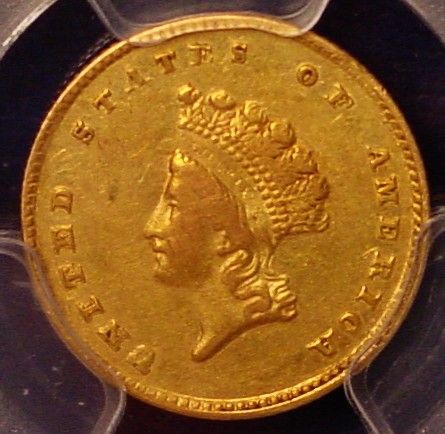
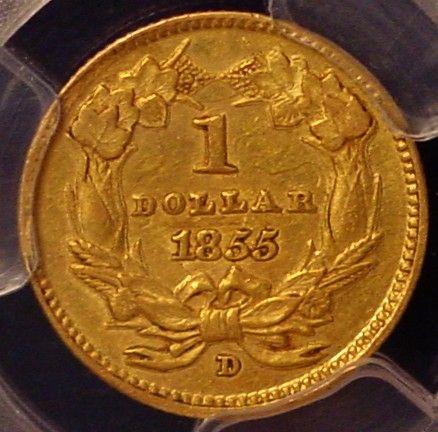
Conversely the Charlotte Mint was never able to produce a well struck Type II Gold dollar. With a fairly high mintage if 9,803, there might have been an opportunity for a well made coin, but to date none have been found. Currently PCGS has grade no 1855-C gold dollar higher than MS-61, and NGC has only graded two pieces as MS-62. This example, which has been graded EF-45 has more sharpness than most examples.

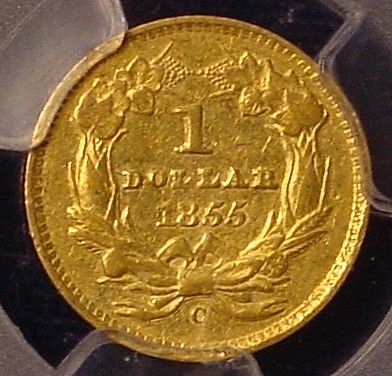
In 1856 James Longacre developed a modified design for the gold dollar. His new design, which strongly resembled his design for the Three Dollar Gold Piece, featured a larger bust for the Indian princess with the same reverse. Most Philadelphia mint coins were well struck. The Charlotte and Dahlonega mints still hard their problems, although the Dahlonega Mint did occasionally produce a nice example such as this 1858-D.

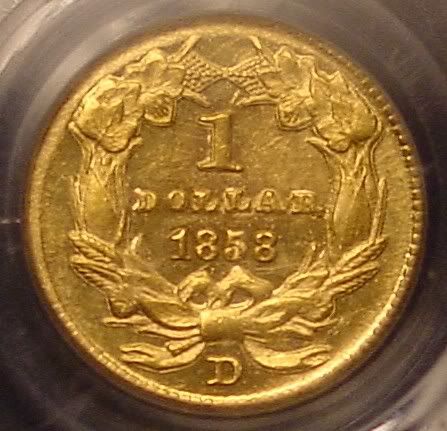
The Charlotte Mint continued to have it's problems, however, which are illustrated by this 1857-C gold dollar.
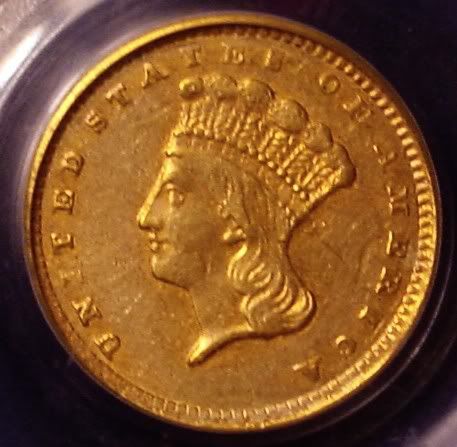
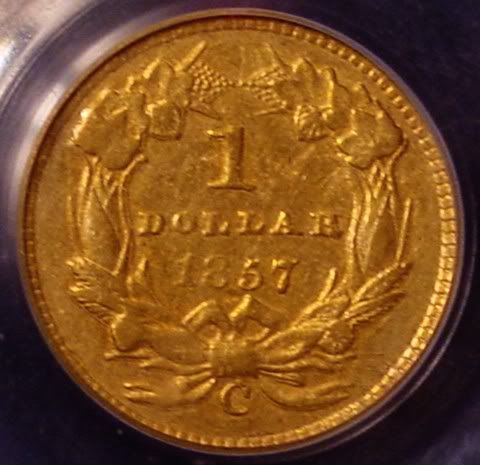
The Charlotte Mint would produce more gold dollars in 1859. Doug Winter notes that these coins were almost as bad as the 1855-C gold dollars. That would mark the final year of gold dollar production at Charlotte. In total the "C mint" would produce perhaps with lowest quality of U.S. coins even produced on a consecutive years basis by a United States mint.
Several solutions were considered. Adding more copper to the mix to make the coin larger was one idea, but once the alloy got to less than 80% gold and 20% copper, the coin began to look too brassy which was an open invitation to counterfeiters. Perforated planchets with hole in the center were considered to the point where they were made up as patterns, but the mint technology that was available at the time made that idea impractical. At any rate the ring around the hole left little room for a design.
The ultimate solution to keep the standard 90% gold, 10% copper alloy and increase the diameter of the planchet to 15 millimeters and reduce the thickness of the coin. The resulting coin still had a diameter that was .5 millimeters smaller than half dime, but at least the coin seemed to be easier to handle.
Collectors call the first "large gold dollar" the "Type II." It featured a slim Indian princess on the obverse and a wreath made agricultural products on the reverse. The legend "United States of America" surrounded the Indian princess on the obverse and the value "1 DOLLAR" and date were in the center of the reverse.
Unfortunately the Type II gold dollar are technically flawed. The relief of the bust on the obverse was too high given the thinness of the planchet and most examples, including those from the Philadelphia mint, were not completely struck on neither the obverse or reverse. Given the problem the Philadelphia mint had striking these coins , it was not surprising that the Charlotte and Dahlonega mints had even greater problems.
The Dahlonega mint coinage in 1855, which was only year the Type II gold dollar was made there, was a scant 1,811 pieces. Most of those coins were poorly struck, but after the first reverse die failed, the Dahlonega mint personnel substituted it with a second die that sometimes yielded surprising results. Those coins, which are now known as (Doug) Winter variety 7-I, had a well struck reverse and a relatively attractive appearance. Today there are only about 12 to 20 examples are known with well struck reverses. Those coins are "closely held" and only occasionally come to market. Here is an example of one of those well struck 1854-D gold dollars.


Conversely the Charlotte Mint was never able to produce a well struck Type II Gold dollar. With a fairly high mintage if 9,803, there might have been an opportunity for a well made coin, but to date none have been found. Currently PCGS has grade no 1855-C gold dollar higher than MS-61, and NGC has only graded two pieces as MS-62. This example, which has been graded EF-45 has more sharpness than most examples.


In 1856 James Longacre developed a modified design for the gold dollar. His new design, which strongly resembled his design for the Three Dollar Gold Piece, featured a larger bust for the Indian princess with the same reverse. Most Philadelphia mint coins were well struck. The Charlotte and Dahlonega mints still hard their problems, although the Dahlonega Mint did occasionally produce a nice example such as this 1858-D.


The Charlotte Mint continued to have it's problems, however, which are illustrated by this 1857-C gold dollar.


The Charlotte Mint would produce more gold dollars in 1859. Doug Winter notes that these coins were almost as bad as the 1855-C gold dollars. That would mark the final year of gold dollar production at Charlotte. In total the "C mint" would produce perhaps with lowest quality of U.S. coins even produced on a consecutive years basis by a United States mint.
Retired dealer and avid collector of U.S. type coins, 19th century presidential campaign medalets and selected medals. In recent years I have been working on a set of British coins - at least one coin from each king or queen who issued pieces that are collectible. I am also collecting at least one coin for each Roman emperor from Julius Caesar to ... ?
0
Comments
Latin American Collection
Ner mind!
<< <i>Great post
Do you have a picture of the 1854-D that you were going to show?
Yes, I goofed up and grabbed the wrong one. It's fixed now.
Another reason that full date 55-D is so rare.
Complete Set of Chopmarked Trade Dollars
Carson City Silver Dollars Complete 1870-1893http://www.pcgs.com/setregistry/showcase.aspx?sc=2722"
Great transactions with oih82w8, JasonGaming, Moose1913.
i had a few charlotte mint gold dollars...all of which i have sold except for this one:
it was the best of the bunch. pcgs45/cac. note the strong 8 in the date and the above average strike for this year.